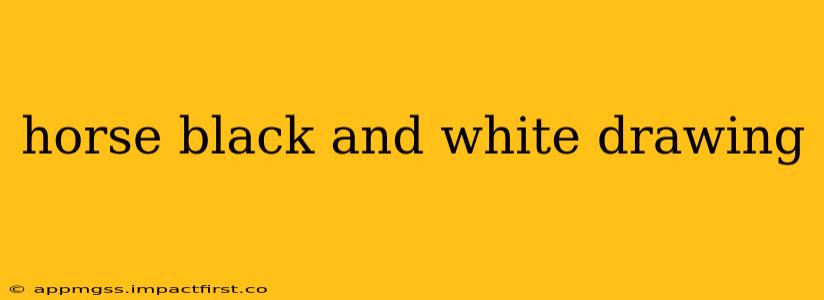Creating a captivating black and white horse drawing requires skill, understanding of form, and a keen eye for detail. Whether you're a seasoned artist or just starting out, this guide explores various techniques and styles to help you achieve stunning results. We'll delve into different approaches, from simple line drawings to intricate shading and hatching techniques, and even explore the impact of different paper choices.
What are the different techniques for drawing a horse in black and white?
Several techniques can be employed to create a black and white horse drawing, each offering unique aesthetic qualities:
-
Line Drawing: This fundamental approach focuses on outlining the horse's form using varying line weights and styles. Thick lines can define the contours, while thinner lines add detail to the mane, tail, and musculature. Experiment with different line qualities—smooth, jagged, or sketchy—to convey different moods and styles.
-
Hatching and Cross-Hatching: This technique involves creating layers of parallel lines to build up tones and shadows. Hatching uses single lines, while cross-hatching overlays lines in different directions, creating a richer, more textured effect. Varying line spacing controls the value—closer lines create darker areas, while wider spaces create lighter ones.
-
Stippling: This involves creating tones and shadows by using dots of varying sizes and densities. Small, closely spaced dots produce dark areas, while larger, more spaced-out dots create lighter areas. Stippling allows for fine detail and a subtle, almost ethereal effect.
-
Blending: While primarily associated with colored media, blending techniques can also be used effectively in black and white drawings using graphite pencils or charcoal. Softening the transitions between values creates smooth gradients and enhances the overall realism of the drawing.
What type of paper is best for a black and white horse drawing?
The paper you choose significantly impacts the final result. Consider these options:
-
Smooth Paper: Ideal for clean, precise line work and stippling. It minimizes texture and allows for sharp details.
-
Textured Paper: This paper adds visual interest and can create a more expressive, less controlled look. The texture can be incorporated into the drawing, adding depth and dimension.
-
Bristol Board: A heavyweight, smooth paper excellent for detailed work and handling erasing without damaging the surface.
-
Sketch Paper: More affordable and readily available, this is a great option for quick sketches and practice.
How do I add shading and texture to my black and white horse drawing?
Shading and texture are crucial for creating a realistic and engaging horse drawing. Consider the following:
-
Light Source: Identify a light source to determine where highlights and shadows fall on the horse's body. This understanding is crucial for accurate shading.
-
Value Range: Use a variety of tones, from the darkest blacks to the lightest whites, to create depth and volume.
-
Texture Variations: Vary your techniques (hatching, stippling, blending) to depict different textures—the smoothness of the coat, the roughness of the mane, and the subtle variations in musculature.
What are some different styles I can use for a black and white horse drawing?
The style you choose will influence the overall mood and aesthetic of your drawing. Consider these options:
-
Realistic: Focuses on anatomical accuracy and detailed rendering of the horse's features and musculature.
-
Impressionistic: Captures the essence of the horse through loose brushstrokes or sketchy lines, emphasizing mood and movement rather than precise detail.
-
Abstract: Simplifies the horse's form, focusing on essential shapes and lines, while disregarding anatomical accuracy.
-
Cartoon/Anime: Utilizes stylized proportions and simplified features for a fun, expressive style.
By exploring these techniques, styles, and paper choices, you can create a truly unique and captivating black and white horse drawing that reflects your artistic vision and skill. Remember practice makes perfect – so keep drawing!
